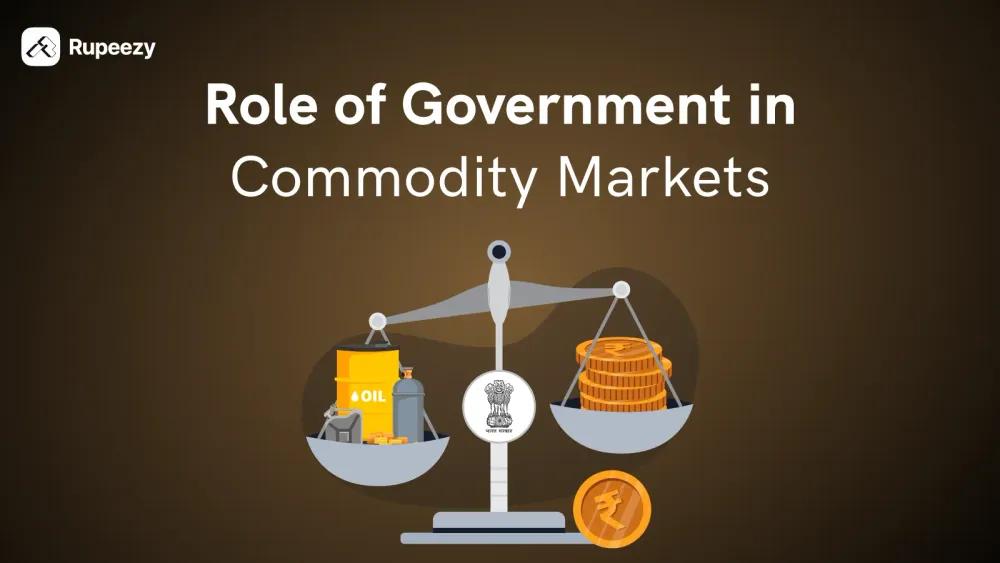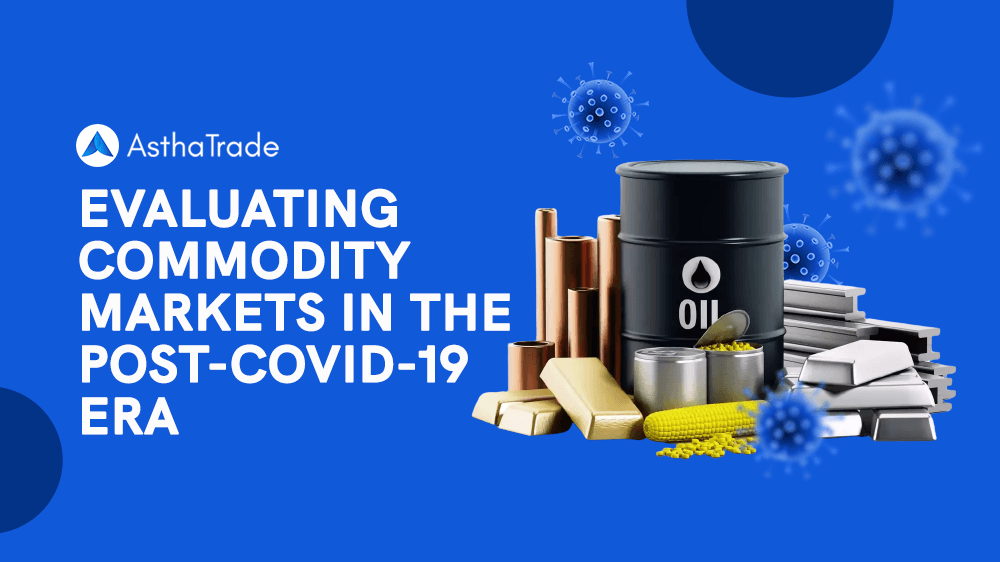Role of Government in Commodity Markets


00:00 / 00:00
For centuries, people traded commodities through the barter system. As economies advanced, these goods gained monetary value, giving rise to organized commodity markets. Today, we trade vital items like gold, silver, food grains, crude oil, metals, and other raw materials. These markets are highly volatile, reacting sharply to demand and supply changes, geopolitical tensions, weather disruptions, and other global factors. In such a dynamic environment, government intervention becomes crucial to stabilize prices, ensure food security, and protect the interests of both producers and consumers.
In this article, we’ll explore why government involvement in commodity markets is necessary, explore how does the government regulates price of commodities, assess the role of global influences, and analyze the role of impact on traders and investors, along with the challenges faced by governments. Let’s deep dive to know more.
Why do Commodity Markets need Government Intervention?
Commodity markets require government intervention primarily due to their volatility, market failures, and the broader economic and social impacts of commodity price fluctuations. Here are some of the key reasons why governments intervene in commodity markets:
Prevent Market Failures and Price Volatility
The commodity markets are often subjected to significant price volatility caused by factors like supply shocks, geopolitical events, weather conditions, and changes in global demand. These fluctuations can cause economic instability, especially in countries heavily reliant on commodity imports. Governments intervene to stabilize prices and protect their respective economies from sudden shocks.
Protect Farmers and Producers
In agricultural markets, governments often intervene to maintain farm incomes and stabilize prices above what the free market would yield. This is done through tariffs, import quotas, export subsidies, direct payments to farmers, and production limits. These measures protect farmers from unpredictable price drops and ensure a stable supply of essential commodities.
Ensuring Food and Energy Security
Governments intervene to secure the availability and affordability of critical commodities like food and energy. During price spikes or supply disruptions, interventions such as subsidies, price controls, or trade restrictions help shield consumers, particularly poorer households, from hardship.
Promoting Social and Economic Equality
Commodity price shocks can affect vulnerable populations. Governments often use subsidies and social welfare programs to protect low-income households from rising prices, to ensure social stability, and promote equality.
Macroeconomic Stability and Fiscal Management
For commodity-exporting countries, price fluctuations can lead to volatile revenues and economic instability. Governments use fiscal policies, sovereign wealth funds, and market-based risk management tools (like futures contracts) to smooth out these fluctuations and maintain macroeconomic stability.
Managing Supply and Demand
Governments often coordinate with supply management schemes to stabilize commodity prices by controlling production levels. However, such schemes may lead to encouraging new producers or reducing demand.
Who Regulates the Market?
Due to the volatility and the need to safeguard against excess speculation, regulatory bodies act as watchdogs for commodity markets. They track price movements and other trends using data analytics and statistics to understand reasons for fluctuations.
Forward Markets Commission (FMC)
It was the chief regulator for India’s forward and futures market, reporting to the Ministry of Consumer Affairs, Food and Public Distribution, as food commodities are traded as futures in India. The central government nominated the FMC chairman. Its objective was to collect information on demand and supply prices and submit it to the central government. It also recommended improving the functioning and organisation of forward markets. In 2015, Finance Minister Arun Jaitley announced the merger of the Forward Markets Commission with the Securities and Exchange Board of India.
Securities and Exchange Board of India (SEBI)
SEBI has regulated the commodity market since 2015, and its decisions directly impact the market. SEBI oversees trading on commodity exchanges like MCX and NCDEX. It ensures that trading in commodity futures and options is fair, transparent, and free from manipulation. It sets rules for exchanges, brokers, and market participants and works to protect the interests of investors in the commodity market.
How does the Government Regulate the Price of Commodities?
After understanding the market regulators, let us look at how does the government regulate the price of commodities.
Minimum Support Price (MSP): Think of MSP as the government's assurance to farmers of a minimum selling price for crops like wheat or rice. It's a safety net, ensuring farmers don't incur losses if market prices drop dramatically. This price is influenced by overall market conditions.
Trade Policies: The government controls what comes in or goes out of the country. By adding taxes on imported goods, like tariffs, or limiting how much can be imported or exported through quotas, they directly affect the supply available in India, which in turn influences how high or low the prices fluctuate.
Price Controls and Subsidies: To help common people, the government sometimes imposes a maximum price on essential goods, like setting a price limit on rice. They also offer subsidies, paying part of the cost, so things are affordable for you to buy, especially through ration shops.
Strategic Reserves: The government stores large quantities of important items like food grains and oil. During shortages or price hikes, they release these stored goods into the market through Open Market Schemes (OMS). This increases supply and helps to control prices. This ensures market stability, especially during adverse weather events.
Specific Commodity Regulations: For key commodities like sugar or edible oils, the government enforces specific rules. For example, the government sets a fair and remunerative price for sugarcane, influencing sugar prices. For cooking oils, they adjust import taxes to protect local farmers and manage the price you pay in the market.
How Government Actions Impact Commodity Prices in India
In 2022, global wheat prices surged due to the Russia-Ukraine conflict, as Ukraine was a major wheat supplier. With a surplus, India had an export opportunity, but domestic prices rose above the government's Minimum Support Price (MSP). To ensure a sufficient domestic supply and stabilise prices, the government restricted wheat exports. While this further pushed global prices, it helped cool domestic rates. The Indian government balanced this by allowing farmers to sell at higher market prices to private traders while continuing MSP procurement, thus protecting both farmer income and consumer prices during volatile times.
How Government Policies Affect Commodity Traders and Investors
After understanding the government's impact on commodity prices, we will look at how government policies can affect the commodity traders and investors.
More Price Swings: Government decisions like sudden export bans or changes in import duties increase price volatility. This means traders can face higher risks as prices can shift rapidly, but such volatility also offers profit opportunities based on accurate predictions. It ultimately depends on investors' analysis and decisions.
Changing Supply and Demand: When the government limits imports or sells from its own stored goods, it directly changes how much commodity supply is available in the market. Traders and investors need to understand these shifts, as they directly influence price movements.
Affecting Buying and Selling Ease: Government procurement for MSP can reduce the supply in the open market, making it harder to buy or sell large amounts easily. Conversely, releasing government stock makes trading easier and increases availability.
Risk of Rule Changes: Traders must contend with the risk of sudden regulatory changes, including trade restrictions. Such changes can directly impact the ability to use trading strategies or limit hedging tools to protect oneself from price changes.
SEBI’s Example of Market Control
Following the policy impact on traders, let us now look at an example of regulatory control on commodity prices. SEBI suspended trading in futures and options for seven key agricultural products like wheat, non-basmati rice, chana, mustard, soybean, palm oil, and moong in December 2021. This move was aimed at curbing price surges in these essential food items, which were driven by speculation. In consultation with the government, SEBI acted to protect consumers from high food prices and inflation. The ban was supposed to last a year, but it has been extended several times, and now it continues till March 2026 to help stabilise prices.
Challenges Faced by Governments in Regulating Prices of Commodities
After the SEBI's impact on commodity prices, we will now explore some of the challenges the government faces while regulating commodity prices.
Interference with Supply and Demand: Government interventions like Minimum Support Price (MSP) and price controls can interfere with the natural forces of supply and demand, which can lead to prices that do not reflect market realities. It can result in overproduction of some crops in which MSP is high, and it can lead to neglecting other crops, resulting in shortages and an insufficient resource allocation.
Fiscal Burden and Financial Costs: The policies, such as providing subsidies and incurring costs for procuring and maintaining buffer stocks, place a strain on government finances. Managing large buffer stocks involves substantial expenses related to storage, maintenance, and handling.
Implementation Complexities and Leakages: Administering price support and distribution schemes across the country, like India, is challenging. The issues, like procurement of commodities from farmers, ensuring fair price shops function correctly, and prevention of black marketing of subsidized commodities, are persistent problems.
External Factors and Volatility: Domestic commodity prices are influenced by global market dynamics, international prices, geopolitical events, and trade policies of other countries. These external factors are beyond the government’s control, and it can undermine domestic price regulation efforts.
Conclusion
To conclude, we explored how the government regulates commodity prices, the roles played by regulatory bodies like SEBI, the tools such as MSP, subsidies, and strategic reserves, and the difficulties in aligning market dynamics with social welfare. Considering these aspects is essential in understanding the broader economic effects of government intervention in commodity markets.
Check Out These Related Articles |
The content on this blog is for educational purposes only and should not be considered investment advice. While we strive for accuracy, some information may contain errors or delays in updates.
Mentions of stocks or investment products are solely for informational purposes and do not constitute recommendations. Investors should conduct their own research before making any decisions.
Investing in financial markets are subject to market risks, and past performance does not guarantee future results. It is advisable to consult a qualified financial professional, review official documents, and verify information independently before making investment decisions.

All Category









